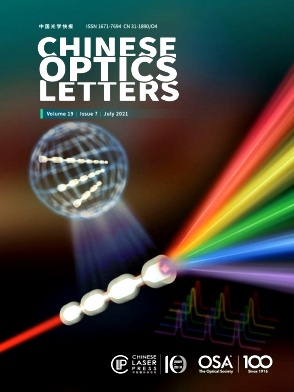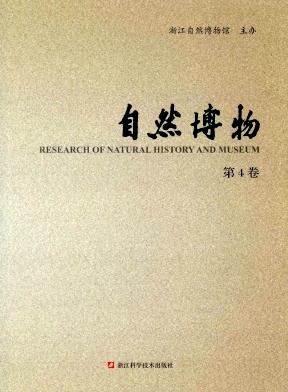
Chinese Optics Letters詳細(xì)信息
Chinese Optics Letters
Chinese Optics Letters
Chinese Optics Letters投稿要求
Chinese Optics Letters雜志投稿須知:
1、 TitleThe title should be concise but informative. Avoid beginning with an article or a preposition. The words "new" or "novel" should be avoided in the title and the text for legal reasons. Titles may be edited by the publisher to facilitate computer search.。
2、 Author names and AffiliationsAuthor names should be given in full and consistent form to facilitate indexing. Affiliations and postal addresses for all authors should appear on the title page.。
3、 AbstractThe abstract should be no longer than 100 words. It should be informative, without descriptive words or citations, and contain the major conclusions and quantitative results or other significant items in the paper. Together with the title, the abstract must be adequate as an index to all the subjects treated in the paper, and will be used as a base for indexing.。
4、 OCIS CodesOCIS codes should be provided to help with indexing. This set of codes was formulated by the Optical Society of America and well-known in the optical research world. OCIS codes are available on Chinese Optics Letters’ web page and the OSA publication web pages. Each manuscript must be given 2-4 OCIS codes below the abstract, and the principal index code should be placed first.。
5、 EquationsEquations should be punctuated and aligned to bring out their structure, and numbered consecutively in round brackets on the right-hand side of the page.Notation. Notation must be legible, clear, compact, and consistent with standard usage. In general, acronyms should be defined at first use. Variables and Vectors. Set single-letter variables in italics (Eg. M). Set vectors in boldface (Eg. m). Functions, derivative "d," abbreviations, and multi-letter identifiers should be set in roman (plain) type (Eg. α, cos, ∫...dx). Fences. For simple bracketing the usual order of parentheses and brackets is { [ ( { [ ( ) ] } ) ] }. Bit and Byte. The standard abbreviations for bit and byte are b and B, respectively. To avoid confusion, these units should be spelled out in most cases (1 bit, 20 GB). Display equations should be broken and aligned for two-column display unless spanning across two columns is essential. Equations should be centered with equation numbers set flush right. For Math Type math, use the Format Equations feature to format all equations as Times + Symbol 10. Note: There must be a blank line space above and below each displayed equation.。
6、 ReferencesReferences should be numbered consecutively in the order in which they are first referenced in the body of the manuscript. Two references [2,3] should be included together, separated by a comma, and three or more consecutive references should be indicated by the bounding numbers and an en dash [1-4]. When compiling your references, be sure to include the titles of articles. COL requires this information before a paper can be sent to peer review. The reference titles will subsequently be removed by copy editors before they are published, so this information is not included in the length estimate sent to authors when a positive decision is made by the editor. All reference authors should be included in the reference list but when reference authors are mentioned in the text, use surnames only (unless further clarity is needed), and use "et al." and first author name when three or more authors are given. The format of references is as follows:Journal paper1、 Q. Ji, X. Ma, J. Sun, H. Zhang, and Y. Yao, "Novel method for measurement of effective cavity length of DBR fiber", Chin. Opt. Lett. 8, 398 (2010).Book2、 N. Bloembergen, Nonlinear Optics (Springer, 1965).Paper in published conference proceedings3、 R. E. Kalman, "Algebraic aspects of the generalized inverse of a rectangular matrix", in Proceedings of Advanced Seminar on Generalized Inverse and Applications 111 (1976).SPIE proceedings4、 S. K. Griebel, M. Richardson, K. E. Devenport, and H. S. Hinton, "Experimental performance of an ATM-based buffered hyperplane CMOSSEED smart pixel array", Proc. SPIE 3005, 254 (1997).Paper accepted for publication5、 H. Qi, M. Zhu, W. Zhang, K. Yi, H. He, and J. Shao, “Dependence of wavefront errors on the nonuniformity of thin film", Chin. Opt. Lett. (to be published).Internet links6、 A. G. Ramm, H. Wang, and J. Ye, "Invisible obstacles", http://www.arxiv.org/abs/math-ph/0608034 (June 1, 2011).Patent。
7、 K. Zhang, J. Zhang, R. Wang, R. Guo, J. Wang, and K. Peng, “All solid state single frequency and frequency-doubled laser” (in Chinese) Chinese Patent ZL98125474、8 (2000).7、 Figures and TablesFigures should be suitable (resolution above 300 dpi) for immediate reproduction and embedded in the text. They should be set as one column wide (6-8 cm) if possible unless two-column display is essential. In the figures, the main lines should be about 0.3 mm in width, and the assistant lines 0.15 mm. Notations in the figures should be distinct and consistent with the same ones in the text, and their font size will be 7-9 pt. Figures should also be uploaded as separate figure files. Each figure should have its own caption. Color Art is Online Only, and free to authors.Tables must be numbered in order of appearance and identified with appropriate titles. The table title, which should be brief, goes above the table. Note that tables are usually typeset, not scanned (tables cannot be electronically reduced in size). Tables should be set in one column wide if possible and be placed near their first mention in the body.。
8、 Article Length and ProofNote that Chinese Optics Letters has a limit of five printed pages. If a paper exceeds this limit, it must be shortened before the paper is accepted. If the page proof is over the five-page limit, the proof must be shortened before the paper can be assigned to a final issue. Authors should use the COL Word or LaTeX templates to prepare manuscripts to facilitate length checking.
Chinese Optics Letters雜志簡介
《Chinese Optics Letters》于2003年創(chuàng)刊,由中國光學(xué)學(xué)會和中國科學(xué)院上海光學(xué)精密機(jī)械研究所主辦,中國激光雜志社出版,美國光學(xué)學(xué)會全球發(fā)行的國際性英文版學(xué)術(shù)期刊。
《Chinese Optics Letters》自創(chuàng)刊時即堅持走國際化辦刊路線,其宗旨是快速、全方位地報道國際光學(xué)領(lǐng)域中的最新理論研究、科技成果和創(chuàng)新技術(shù)。
《Chinese Optics Letters》目前已被SCI-E、EI、CA、CSA和MSB-S等世界知名檢索機(jī)構(gòu)收錄。2014年SCI影響因子為1.851。
《Chinese Optics Letters》是我國唯一全面反映激光領(lǐng)域最新成就的英文版專業(yè)學(xué)報類期刊。主要發(fā)表我國在激光、光學(xué)、材料應(yīng)用及激光醫(yī)學(xué)方面卓有成就的科學(xué)家的研究論文。
《Chinese Optics Letters》為月刊,每月10號出版。審稿周期約30天,平均發(fā)表周期約100天。COL采用OCIS編碼對論文進(jìn)行分類,方便作者、讀者查閱。每篇論文都具有DOI號,便于在CrossRef系統(tǒng)中被交叉引用。
Chinese Optics Letters統(tǒng)計分析
影響因子:指該期刊近兩年文獻(xiàn)的平均被引用率,即該期刊前兩年論文在評價當(dāng)年每篇論文被引用的平均次數(shù)
被引半衰期:衡量期刊老化速度快慢的一種指標(biāo),指某一期刊論文在某年被引用的全部次數(shù)中,較新的一半被引論文刊載的時間跨度
他引率:期刊被他刊引用的次數(shù)占該刊總被引次數(shù)的比例用以測度某期刊學(xué)術(shù)交流的廣度、專業(yè)面的寬窄以及學(xué)科的交叉程度
引用半衰期:指某種期刊在某年中所引用的全部參考文獻(xiàn)中較新的一半是在最近多少年時段內(nèi)刊載的
平均引文數(shù):在給定的時間內(nèi),期刊篇均參考文獻(xiàn)量,用以測度期刊的平均引文水平,考察期刊吸收信息的能力以及科學(xué)交流程度的高低
熱門評論
速度還是很快的,一個月后得到通知讓修改繼續(xù)投,意見特別詳細(xì),要求比較高,第一次大修以后投出去,兩個月以后回信基本可以了,再修改下就可以了,審稿人特別負(fù)責(zé),最后一遍修改的時候,審稿人把我文章里面所有錯誤的標(biāo)點(diǎn)符號都修改過來了,特別負(fù)責(zé)。總體上,8月29號投的,9月30號第一次修改,11月份第二次修改,基本上是接收了,再次修改,次的4月份刊出來。
俗話說一口吃不出一個胖子,但吃成胖子的決心和毅力絕非那些一般人所能理解的,正好趕上投稿網(wǎng)活動,一口氣買了一大堆,接下來慢慢體會與鑒賞。物流技術(shù)與應(yīng)用是我一直很青睞的。
還是比較不錯的的期刊,編輯的效率高,審稿人意見專業(yè)、審稿速度快。基本1個月內(nèi)搞定,從投稿到見刊共需要8個月時間,但是版面費(fèi)有點(diǎn)貴。。。
感覺和被拒的諸位情形有點(diǎn)像,11月20號左右投了一篇綜述,一個月后直接退稿了,建議轉(zhuǎn)投,打電話問了主編,主編說沒有送外審,是初審不通過,可是初審不通過可以早點(diǎn)給我通知啊,要一個月之久真是讓有點(diǎn)浪費(fèi)投稿人的時間呀。然后叫我再等一會,過了一會打電話過來跟我說了2個被拒的理由。
Chinese Optics Letters是不錯的雜志,投了這個雜志半個多月后錄用,審稿老師很認(rèn)真的,提的意見及建議確實(shí)很有價值,后面按老師的要求修改了一回就中了。雜志社的編輯老師態(tài)度也很親和,good job!!雜志挺好的。
Chinese Optics Letters初審及初篩較快,專家很認(rèn)真負(fù)責(zé),每點(diǎn)都幫你挑出來給你怎么修改的提示,修改了2次才錄用。將近2個月終審結(jié)束,給出審稿意見。審稿費(fèi)及版面費(fèi)暫時還沒要求收取。
費(fèi)了不少功夫,6月底寫出了一篇文章,8月初才投Chinese Optics Letters雜志,10月給了修改后錄用,提的幾點(diǎn)修改意見只是一些小問題,11月10日拿到錄用證明,真好。這是本人第一篇核心雜志,真的很高興。總體感覺Chinese Optics Letters雜志的編輯服務(wù)態(tài)度很不錯,審稿速度挺快的,給個贊!
投稿接受后還有多次校稿,Chinese Optics Letters雜志編輯非常仔細(xì),也是很好的學(xué)習(xí)的過程。因?yàn)楸痪軐徣危系臅r間比較長,問編輯部進(jìn)展,編輯部很快回信說初步接受,可以給刊用通知,也很快收到了。給個贊!
該期刊審稿嚴(yán)格,各項(xiàng)工作規(guī)范,在線通告系統(tǒng)可實(shí)時知道審稿進(jìn)度,編輯很認(rèn)真負(fù)責(zé),有郵件必回,收到稿件后迅速送審,審稿專家提出的問題也相當(dāng)有深度,具有專業(yè)性。是一個不錯的期刊!
總的來說速度還算比較快,雖然中間修改的較多,但是只要錄用了見刊的速度不是其他雜志能比。Chinese Optics Letters編輯的態(tài)度非常好,回復(fù)郵件也相當(dāng)快,經(jīng)常下班了還修稿,溝通意見。
相關(guān)問題
- Chinese Optics Letters是正規(guī)期刊嗎?
- Chinese Optics Letters是什么級別的期刊?是核心期刊嗎?
- Chinese Optics Letters評職稱可以嗎?單位認(rèn)可嗎?
- Chinese Optics Letters是北大核心嗎?是中文核心嗎?
- Chinese Optics Letters是科技核心嗎?
- Chinese Optics Letters是統(tǒng)計源核心嗎?
- Chinese Optics Letters是南大核心CSSCI嗎?
- Chinese Optics Letters是CSCD期刊嗎?
- Chinese Optics Letters是國家級期刊嗎?
- Chinese Optics Letters是SCD期刊嗎?
- Chinese Optics Letters是國家新聞出版署第一批、第二批學(xué)術(shù)期刊嗎?
- Chinese Optics Letters好投嗎?Chinese Optics Letters簡介
相關(guān)期刊
更多常見問題
| Q:論文發(fā)表的時候可以一稿多投嗎? |
| A:一稿多投的行為是典型的學(xué)術(shù)不端的行為,是國內(nèi)外學(xué)術(shù)界都明令禁止的行為,原因主要在于涉及到文章版權(quán)歸屬的問題,如果作者的文章已經(jīng)被某個雜志社錄用,或者同時被兩家雜志社錄用,就會涉及到版權(quán)糾紛,作為雜志社都會保護(hù)本社的合法權(quán)益,到這時作者就會比較麻煩,吃官司都是小事兒了,被打入黑名單降級降職影響可就太大了。 |
| Q:職稱論文發(fā)表對時間有限制嗎? |
| A:職稱論文發(fā)表并沒有明確規(guī)定截止時間,需要作者結(jié)合自己所在地區(qū)的具體規(guī)定自己安排發(fā)表時間,一般職稱評審,各地區(qū)都會明確規(guī)定申報材料的最后期限和截止日期,我們結(jié)合這個日期來考慮何時發(fā)表文章就可以,大部分地區(qū)職稱評審都集中在每年的8-10月之間,有的地區(qū)要求7月中旬開始交材料,最晚8月底之前,有的則是要求8月中旬交,還有部分地區(qū)要求截止時間為申報時間上年的12月31日,所以,各個地區(qū)的具體要求并不同,申報者需要在提交材料前確保自己的文章已經(jīng)見刊并且被相應(yīng)的數(shù)據(jù)庫檢索即可。 |
| Q:網(wǎng)上發(fā)表論文如何防騙?可靠網(wǎng)站與可疑網(wǎng)站如何區(qū)分? |
| A:由于發(fā)表論文的需求遠(yuǎn)遠(yuǎn)多于雜志版面的供應(yīng),再加上眾所周知的審稿難!審稿慢!選擇論文發(fā)表網(wǎng)站發(fā)表表論文確實(shí)能解決以上問題。賣方市場的出現(xiàn)加之發(fā)表論文的剛性需求,就導(dǎo)致出現(xiàn)先付款后發(fā)表的現(xiàn)狀。論文發(fā)表網(wǎng)站正規(guī)與否是通過網(wǎng)站從始至終所提供服務(wù)體現(xiàn)出來的,任何交易只要存在時間差都會有風(fēng)險,但這個風(fēng)險是可以通過您的智慧來避免的。因?yàn)椴皇撬姓撐木W(wǎng)站都是騙子,你要做的就是過濾掉沒保障的網(wǎng)站,選擇可靠的論文發(fā)表網(wǎng)站! |
| Q:一般期刊需要提前多久準(zhǔn)備? |
| A:省級、國家級期刊建議至少提前6個月準(zhǔn)備。一般來講,雜志社為了確保每期雜志正常出刊,都會提前將當(dāng)期之后1-3個月的稿件提前安排好,而一些創(chuàng)刊較早,認(rèn)可度更高的熱門期刊,來稿量較大,發(fā)表周期可能就會更久。提前準(zhǔn)備,意味著雜志的可選擇性更多。 |
| Q:核心期刊需要提前多久準(zhǔn)備? |
| A:核心期刊建議至少提前12個月準(zhǔn)備,核心期刊正常的審稿周期為1-3個月,且審核嚴(yán)格,退稿、返修幾率更大,這意味著在流程上耗費(fèi)的時間更久,且核心期刊版面有限,投稿競爭更加激烈,即使被錄用,排刊也比普通期刊晚很多,因此需要更早準(zhǔn)備。 |

刊.jpg)
博物館研究.jpg)
新時代.jpg)
.jpg)
.jpg)
于我們.jpeg)